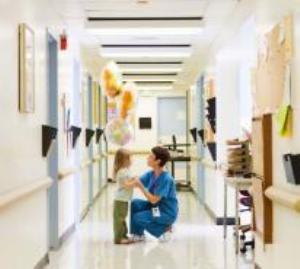Mar 12 2013
Introducing a fleet of social robots in a hospital, so that they can interact with children affected by cancer, will be the final outcome of a new international research project that Universidad Carlos III of Madrid (UC3M) is participating in.
 Hospital
Hospital
The objective is to design and build these devices and to advance the study of societies in which humans and robots mix.
The MOnarCH project (Multi-Robot Cognitive Systems Operating in Hospitals), which involves researchers from approximately ten European companies and research centers, intends to introduce a set of robots that collaborate with medical personnel, relating with the children who are patients in the pediatric ward of the hospital of the Instituto Portugués de Oncología de Lisboa (Portuguese Oncological Institute of Lisbon).
There are several cases that have shown that interacting with robots can be beneficial for certain patients. In the United Kingdom, for example, studies have explored the possibility of using social robots with autistic children. And in Japan, the robot known as Paro (which is shaped like a baby seal, with white fur and black eyes) has been successfully used to improve the state of mind of elderly people and to reduce stress among patients and their caregivers. In fact, it was used in some cases to treat the depression suffered by survivors of the earthquake and subsequent tsunami that devastated the northeast coast of Japan in March of 2011.
The objective of the MonarCH project is to further advance in this direction, making a significant qualitative leap forward. Rather than using a single robot, they will use several formats simultaneously. And instead of attending to a single patient, the fleet of robots will relate with all of the patients on the floor. “In addition, we intend to move forward in the development of robots that can carry on autonomously for long periods of time without the aid of their operators, which is something that at this point has not been achieved in such complex situations,” comments the head of the project at UC3M, Miguel Ángel Salichs, a full professor in the University’s Systems Engineering and Automation Department.
The scientists in UC3M’s Robotics Lab will be responsible for developing and programming all of the robots’ behaviors that are related to interaction between robots and humans, whether it is with hospital personnel or with the children. “Some of these behaviors consist in establishing a conversation with users, providing information to the staff or even playing with the children, so the behaviors must be varied and they must allow the robots to adapt to the needs of each individual they are going to deal with,” explains another Robotics Lab researcher, Víctor González Pacheco.
Technological and social challenges
This project will entail both technological and social challenges, according to the researchers involved. From a sociological point of view, there are very few studies looking into relationships between humans and robots over the long term, which means that this project is the first that will help to understand the dynamics of the social interactions in situations where groups of robots cooperate with humans in work and hospital environments. Moreover, the project will serve to establish the first framework that will enable the establishment of a series of ethical considerations that must be taken into account in these situations.
Technologically speaking, MOnarCH presents a major challenge, because it takes these types of robots out of the laboratory and moves them into a real environment. Up until now, most of the research on social robotics has taken place in very controlled environments. “In this case,” points out Professor Salichs, “the introduction of a group of autonomous social robots into surroundings with these characteristics is something new, and we hope that the project will help us to advance in the development of robots that are able to relate to people in complex situations and scenarios.”
In order to achieve all of this, the researchers will have to work in various fields. In the first place, they will have to improve on the current perception techniques that are relevant to human-robot interaction. In addition, they will explore new interfaces for interacting with these machines and they will advance in the further development of those that are already in existence. They will also design, construct and program a series of robots that are capable of exhibiting social behaviors. Finally, they will develop a framework for the study and modeling of mixed human and robot societies, which will include a map of the different principles that must govern those societies, thus helping to establish the robots’ rules of behavior.
The MOnarch project is part of the Seventh EU Framework Programme, which began just a few weeks ago, and which is projected to last for three years. This project will cost approximately 4.5 million euros, of which the EU will fund just over 3.3 million euros. A total of nine partners representing five different European countries are participating: Spain, with researchers from Universidad Carlos III of Madrid; Portugal, with scientists from the Instituto Superior Técnico (Technical College), which heads the project, the hospital of the Instituto Portugués de Oncología de Lisboa (Portuguese Oncological Institute of Lisbon), and the following companies: IDMind, Selftech and YDreams; Holland, with researchers from the University of Amsterdam; Sweden, with scientists from the University of Orebro; and Switzerland, with researchers from the Federal Engineering College of Lausanne.